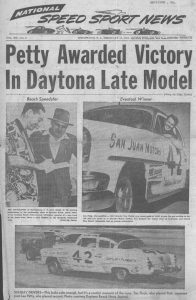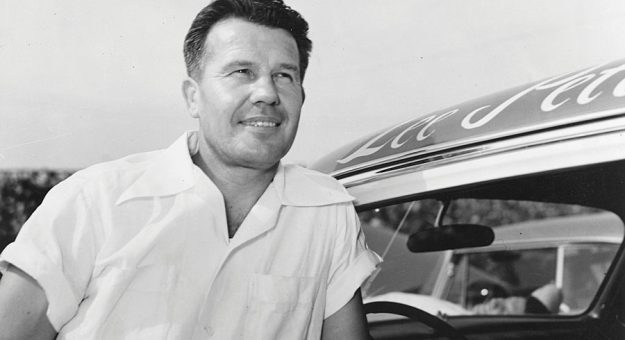Editor’s Note: NASCAR is celebrating its 75th anniversary in 2023. SPEED SPORT was founded in 1934 and was already on its way to becoming America’s Motorsports Authority when NASCAR was formed. As a result, we will bring you chapter 7 of a 75-part series on the history of NASCAR as told in the pages of National Speed Sport News and SPEED SPORT Magazine.
Fresh off the most dominant season-to-date in NASCAR’s six-year history, Herb Thomas opened the 1954 schedule with a spectacular victory in West Palm Beach, Fla.
Thomas led down the homestretch with Buck Baker on his bumper but crashed into the wall five yards before the finish line. However, his momentum propelled him across the stripe just ahead of Baker. He followed this fortunate happening with victories at Jacksonville (Fla.) and Atlanta Speedways to give him top honors in three of the first four races on the NASCAR Grand National division schedule.
Thomas’ early-season performance in his No. 92 Hudson Hornet suggested a repeat of 1953, yet “Mr. Consistency,” Lee Petty never allowed the champ to coast. Petty watched Thomas’ victory march in the initial race of the season from behind, much as he trailed the defending NASCAR champion in the final points tally of 1953.
Two weeks later at the 4.1-mile Daytona Beach road course, Petty earned the pole with a record 123 mph qualifying speed and led the field going into the north curve but slid to the rim. At the moment, his 1954 Chrysler grazed the railing, Thomas dove under the No. 42 car for the point. Petty regained control and grabbed the lead again on the 11th circuit before Tim Flock overtook him a few laps later and held off Petty for the apparent victory.
However, Petty inherited the celebrated Daytona Beach laurels upon Flock’s disqualification for an altered carburetor found in his 1954 Oldsmobile 88.
Loyalty To Strictly Stock Specifications
Despite car owner Ernest Woods’ insistence that Flock first saw the car when he arrived for the race, Bill France stood by NASCAR’s decision about Flock’s loyalty to NASCAR’s strictly stock specifications. Prior to Speedweek at Daytona Beach, France named Tom McCahill to oversee Speedweek activities and to enforce the strictly stock classification he desired to legitimize.
The Feb. 17 issue of NSSN quoted Benny Kahn, sports editor of the Daytona Beach News-Journal, on the meaning of McCahill’s appointment: “The NASCAR speed trials, under the supervision of respected automobile authority McCahill, will be 100 percent on the level this year.”

McCahill made post-race inspections, like the one that disallowed Flock’s victory, mandatory for all competitors at all strictly stock car races.
Thus, Kahn concluded, “If they find any extracurricular doodads inside the engine, or out, or get a sniff of doped fuel from the gas tank, or discover any other tampering to soup up the strictly stock automobiles, the entry is thrown out. Period.”
NASCAR’s members wrestled with the specifics regarding strictly stock car specifications. Controversy arose when Hudson Motor Corp. introduced its 1954 models complete with Twin H power.
Non-Hudson drivers complained that Twin H power was a power-enhancing kit akin to the kind which NASCAR sought to eliminate from the Grand National division.
Other automobile manufacturers feared Hudson’s increased domination of victory lane.
After much debate, the decision regarding Twin H power appeared in the Jan. 20 issue of NSSN: “Due to the fact that cars come off the assembly line thus equipped and are advertised by Hudson as being available to everyone this car will be allowed to compete in NASCAR Grand National circuit events.”
However, Hudsons thus equipped were made to “carry a sign on the hood or the regular Twin H Power insignia identifying the Hudson cars so equipped.”
Meanwhile, on the track, the battle between the car companies continued as Hudson-faithful Thomas, Oldsmobile driver Baker and Chrysler and Dodge exponent Petty jockeyed for position in the top three of the standings.
Thomas streaked through the schedule setting record after record at tracks across the country.
The lead-footed pilot lapped the field in Hickory, N.C., and tied the record he established for most victories in a season with 12. He secured eight poles and 37 top-10 finishes en route to becoming the first $30,000 winner in NASCAR.
Meanwhile, Baker won four races and racked up 28 top-10s to secure third in the standings.
Introducing ‘Mr. Consistency’
True to his nickname, “Mr. Consistency,” Petty ended 33 of the 34 races he started in the top 10 including seven victories. Petty also topped $20,000 in earnings for the third year in a row on the way to his sixth top-four points finish in his six years of NASCAR Grand National competition.
Petty’s consistency led to his first championship.
Two months prior to Petty clinching his title with a victory at Martinsville (Va.) Speedway, the Aug. 25 NSSN recorded Bill France’s historic announcement: “After considerable study, planning, engineering and financial detailing, the (Daytona Beach Superspeedway) project is ready to move ahead.”
With the Daytona Beach Racing and Recreation Authority’s acceptance of a Cincinnati Ohio, municipal bond firm proposal to sell $1.5 million in revenue bonds for speedway financing, Bill France’s dream oval was set to become a reality.
In NASCAR’s other divisions, Jim Reed repeated as the short track late model champ and Californian Danny Graaves took the sportsman title. Jack Choquette raced to the modified crown while Connecticut’s Chuck Arnold was the midget king. NASCAR expanded across the nation with the notable addition of the tracks under the California Stock Car Racing Ass’n’s Robert Barkhimer.
